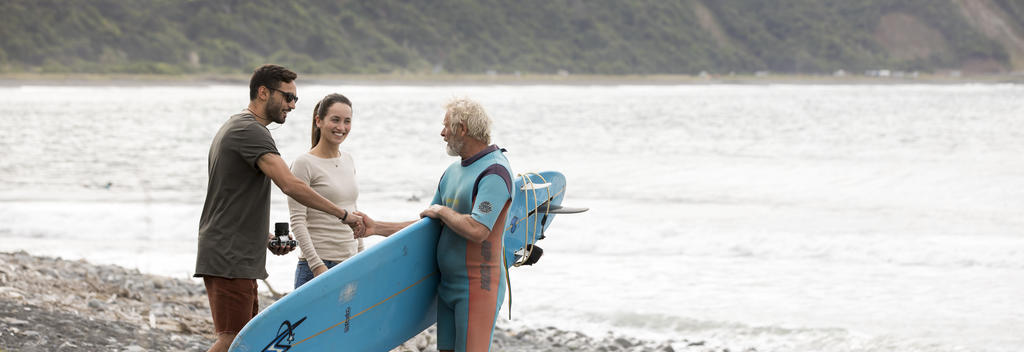Head out of Auckland and right away you will have a choice of East or West Coast surfing. Muriwai and Piha on the West Coast offer black sand beaches with wild waves. In the far north is Shipwreck Bay which is definitely worth a visit - if not for the waves then the blokarting, kayaking and 4WD beach tours along Ninety Mile Beach to Cape Reinga.
Take in both coasts by driving the Twin Coast Discovery Highway on a surf tour. The golden beaches of the East Coast are often edged with magnificent Pohutukawa trees. Mangawhai and Te Arai are eternally popular surf spots on the east coast. Travel north to Whangārei, and see a harbour full of fishing boats, pleasure craft and yachts to rival the City of Sails.
If it’s a purist, almost iconic, surfing community you’re looking for travel south of Auckland to the Waikato. Raglan is located on the West Coast and the superb surfing conditions of Manu Bay are famous throughout New Zealand.
Surfing the East Coast of the North Island: Coromandel, Bay of Plenty, Tairawhiti
The east coast of New Zealand is simply beautiful, remote and peaceful with surprises around every corner. Venture up to Hot Water Beach in the Coromandel for something different; create your very own natural spa bath, or surf the beach and reef breaks.
New Zealand’s first artificial reef is located in Mt Maunganui, Bay of Plenty. As the name indicates there is plenty of excitement to be had in the Bay. Surfing, fishing, sailing or just relaxing on the stunning beaches are some of the activities that cater for everyone in this region.
As the first place to see the sunrise in the world Gisborne is great for dawn surfing. Waikanae beach is located right in town and is great for learning. Home to some of the best breaks in New Zealand, receiving south, east and south east swells, Gisborne always produces the goods.
Surfing the Lower North Island: Taranaki, Wellington
The New Plymouth area was the dramatic filming location for the movie "The Last Samurai", nearby are multiple surf beaches which stretch throughout Taranaki. Fitzroy beach is popular due to its accessibility and dependable surf. Journey south of New Plymouth via Surf Highway 45 through Ōakura and Ōpunake and select one of the many quality breaks on offer.
Only minutes from the city of Wellington is Lyall Bay which receives southerly swells to the delight of the many locals. Surf the day away then spoil yourself with an evening dinner and experience theatre in the cultural capital.
Round the corner from Wellington is Wairarapa with unpopulated waves just waiting to be discovered. Go off road and sample the reef and beach breaks, but be wary of big southerly swells, rugged conditions and changing weather patterns.
Surfing the South Island: West Coast, Canterbury, Otago, Southland
Venture to the West Coast of the South Island, meet the friendly locals, admire spectacular views and surf from Westport to Greymouth. A road trip on the west coast is guaranteed classic times and amazing fun.
Kaikoura is well known for whale watching and swimming with the sociable Dusky dolphins. But while surfing it is far more likely you’ll come across a curious seal. Drive along the coast and observe the conditions of Mangamanu, Meatworks, and Oaro and drop in for a session.
North of Christchurch are many surf spots, from the long New Brighton beach to Jack’s Point south of Timaru. Have fun fishing, kayaking, windsurfing or kiteboarding at New Brighton with lessons available and equipment on hire.
Dunedin is undoubtedly one of the best surfing regions in New Zealand with a large number of breaks within close vicinity of each other. Despite the cooler temperatures surfers frequent beaches from Karitane to Brighton.
Discover the true essence of surfing in the deep south with long summer days, peaceful beaches and beautiful scenery. Nature will deem your respect, whether it’s the grace of dolphins at Curio Bay or the enormity of the Papatowai surf.













